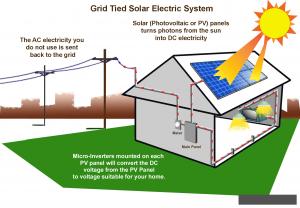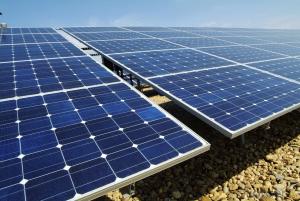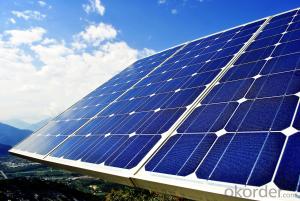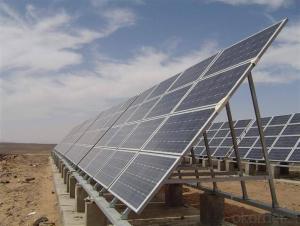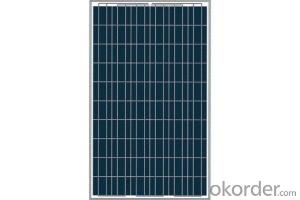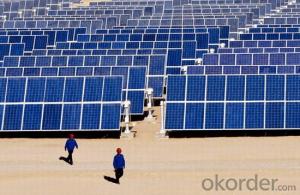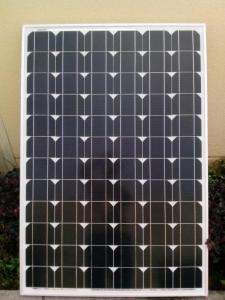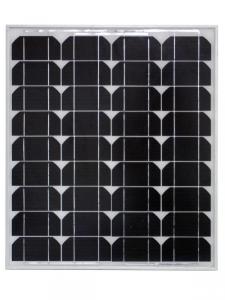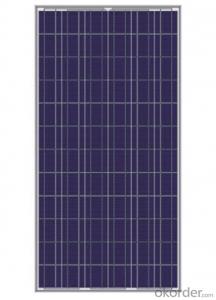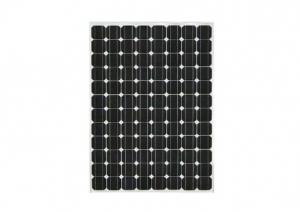Jc Solar Panels Polycrystalline Solar Panels 150w with High Efficiency
- Loading Port:
- China main port
- Payment Terms:
- TT OR LC
- Min Order Qty:
- 1000 watt
- Supply Capability:
- 1000000 watt/month
OKorder Service Pledge
OKorder Financial Service
You Might Also Like
Specification
Introduction of Poly solar panels CNBM
Polycrystalline Solar Panels 150W With High Efficiency
CNBM Solar photovoltaic (PV) Panel is designed for large electrical power requirements. It is the optimal choice for both on-grid and off-grid power systems. CNBM Solar panel offers high performance of power per square foot of solar array. Monocrystalline silicon(c-Si): often made using the Czochralski process. Single-crystal wafer cells tend to be expensive, and because they are cut from cylindrical ingots, do not completely cover a square solar cell module without a substantial waste of refined silicon. Hence most c-Si panels have uncovered gaps at the four corners of the cells.
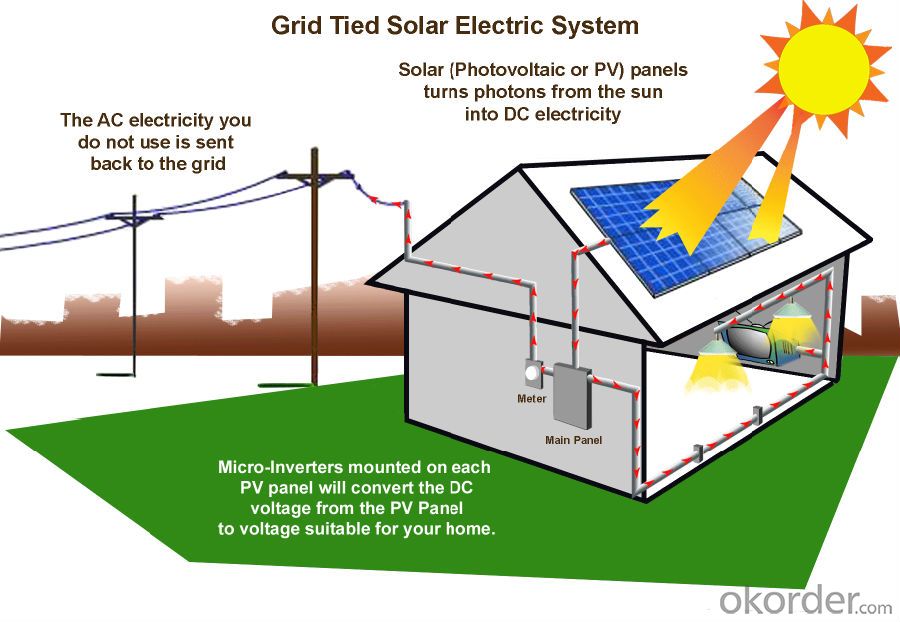
Feature
1.Solar Cell : High efficiency crystalline solar cell. Even if under the weak light, the solar module can produce maximum power output.
2.Tempered glass (toughened glass): Anti-reflecting coating and high transmission rate glass increase the power output and mechanical strength of solar module.
3.EVA and TPT: Using high quality EVA and TPT to prevent destroying and water.
4.Long lifetime: ≥25 years; Less power decrease.
5.Resisting moisture and etching effectively, not effected by geology.
6.The certificate issued by international authority: UL, TUV, IEC, VDE, CE.
Specification
Characteristics of Poly solar panels CNBM | |||||
Max Power Voltage Vmp(V) | 30.3 | 30.8 | 31.1 | 31.4 | 31.85 |
Max Power Current Imp(A) | 7.60 | 7.64 | 7.73 | 7.81 | 7.85 |
Open Circuit Voltage Voc(V) | 36.1 | 36.6 | 37 | 37.3 | 37.68 |
Short Circuit Current Isc(A) | 8.50 | 8.55 | 8.65 | 8.75 | 8.85 |
Max Power Pm(W) | 230W | 235W | 240W | 245W | 250W |
Temperature Coefficient of Cells Poly solar panels CNBM | |
NOCT | 45℃ ± 2℃ |
Temperature Coeffucients of Isc (%/℃) | 0.0492 |
Temperature Coeffucients of Voc (%/℃) | -0.3374 |
Temperature Coeffucients of Voc (%/℃) | -0.4677 |
Mechanical Data of Poly solar panels CNBM | |
Dimension | 1638 × 982 × 40 mm |
Weight | 19.5 kg |
No. of Cells and Connections | 60 (6 ×10) |
Tolerance | 0 ~ + 5 W |
Cell | Monocrystalline Cell 156 × 156 mm |
Packing | 624 Pcs/40ft(H) Container |
Limits of Poly solar panels CNBM | |
Operating Temperature | -40℃ to +85℃ |
Storage Temperature | -40℃ to +85℃ |
Max System Voltage | 1000VDC(IEC) / 600VDC(UL) |
Guarantees of Poly solar panels CNBM | |
Products Guarantee | 12 yrs free from defects in materials and workmanship |
Performance Guarantee | No less than 90% within 10yrs and no less than 80% within 25yrs |
Certificates | TUV(IEC61215&IEC61730),VDE(IEC61215&IEC61730),UL,CE |
Packaging Information
Package:26pcs/box
Quantity:1 box/pallent
Loading Capacity:952pcs/40ft
- Q: Why would someone use a solar panel? Does it have to do with the economy right now, global warming, or what?
- solar cell is a solar cell solar panel are many solar cells.... Typically people refer to a single solar panel as a solar panel, even though they should be reffering to it as a solar cell. A solar panel is a panel of solar cells working in conjunction with each other. I hope that makes sense it is just the incorrect terminology people always use.
- Q: Hi, i want to please a solar panel in Lima Peru, my Latitude is -2 and longitude -77. I understand that since i am in the southern hemisphere, my panel should be pointing north. However, i am using a program called pvdesigner, and according to this, y should face my panel with and azimuth of 00degrees (0 = south) and a tilt of 60degrees. Does this make any sense?thanks
- Typically, solar panels are installed facing the same as your latitude = 2 degrees to the North measured from horizontal. 60 degrees from vertical = 30 degrees from horzontal will give almost as much power in June as in December = beginning of Summer. You can face your panels straight up = zero tilt from vertical = better for December/ not so good in June. Usually, the same tilt as your North facing roof is best as it simplifies installation and reduces wind loading. Shade from trees etc will much reduce the power you get. Neil
- Q: How do solar panels affect the property's sustainable development goals?
- Solar panels can greatly contribute to a property's sustainable development goals by providing clean and renewable energy. By harnessing the power of the sun, solar panels reduce reliance on fossil fuels, decrease carbon emissions, and promote environmental sustainability. Additionally, the installation of solar panels can lead to long-term cost savings on electricity bills, enhancing economic sustainability. Overall, solar panels play a crucial role in advancing a property's sustainable development goals by supporting both environmental and economic sustainability.
- Q: Do solar panels require regular inspections?
- Yes, solar panels do require regular inspections to ensure optimal performance and identify any potential issues such as damage, debris, or faulty connections. Regular inspections can help in maintaining the efficiency and longevity of the solar panels.
- Q: Can solar panels be installed on a flat roof?
- Yes, solar panels can be installed on a flat roof. In fact, flat roofs are often considered ideal for solar panel installations due to their easy accessibility and potential for optimal sun exposure. Additionally, there are various mounting systems available that can be used to securely attach solar panels to flat roofs.
- Q: Can solar panels be used for powering security systems?
- Yes, solar panels can be used to power security systems. Solar panels convert sunlight into electricity, which can be used to power various devices, including security cameras, alarms, and sensors. This allows security systems to operate independently of the electrical grid, making them more reliable and cost-effective in remote locations or areas prone to power outages. Moreover, solar-powered security systems are also environmentally friendly, reducing reliance on fossil fuels and minimizing carbon emissions.
- Q: Can solar panels be used in areas with high levels of radiofrequency interference?
- Yes, solar panels can be used in areas with high levels of radiofrequency interference. However, it is important to ensure proper grounding and shielding measures are in place to minimize the impact of radiofrequency interference on the performance of the solar panels.
- Q: Do solar panels require a specific type of inverter for converting DC to AC power?
- Yes, solar panels require a specific type of inverter known as a solar inverter to convert the direct current (DC) power produced by the panels into alternating current (AC) power that can be used in households or fed into the electric grid.
- Q: Can solar panels be installed on a church or religious building?
- Yes, solar panels can be installed on a church or religious building. In fact, many religious institutions have embraced solar energy as a sustainable and environmentally friendly solution to meet their energy needs. Installing solar panels on these buildings not only helps them reduce their carbon footprint but also promotes a message of stewardship and responsibility towards the planet.
- Q: why don't we take a cue from mother nature and make our soar panels like trees? thousands of leaves or needle (like a pine tree) instead of one big flat panel? I mean it seems to work pretty good for all the plants i see why would it not work for us. It would be aesthetically pleasing and with the right engineering wouldn't it make them not have to worry about tracking the sun? i already have some ideas about the process of making them just no available labratory.
- Because we and the trees are trying to solve a different problem. We want electricity, a tree wants light (and some heat) for photosynthesis. In getting the electricity we use Silicon for solar panels. (Sometimes Gallium Arsenide). And we exploit the same thing in Silicon that allows them to be computer chips. The fact that they conduct differently when voltage is applied. But for a solar panel that is done essentially in reverse. We GET a voltage difference (electricity) from shoving energy through it. Look up junction bias on google or yahoo for explanation. But the DESIGN problem is: You have to couple these panels together the right way - according to their bias. You can't string them up willy nilly. There is a pattern. And when one breaks in this pattern. (I mean when the actual panel cracks, which they do easily as they are brittle). It can change the overall bias. This can make even be worse than if it was removed, it can actually fight against the working ones. The efficiency is there in arranging them like a tree, but the practicality of maintenance would be daunting.
Send your message to us
Jc Solar Panels Polycrystalline Solar Panels 150w with High Efficiency
- Loading Port:
- China main port
- Payment Terms:
- TT OR LC
- Min Order Qty:
- 1000 watt
- Supply Capability:
- 1000000 watt/month
OKorder Service Pledge
OKorder Financial Service
Similar products
Hot products
Hot Searches
Related keywords
